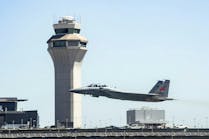Asia-Pacific Global Military-Fixed Wing Market to be Worth US$42.2bn by 2031, Says GlobalData
The Asia-Pacific (APAC) region will lead the global military-fixed wing market between 2021 and 2031 as China, India, Japan and Taiwan aim for multi-year procurement programs. The fixed-wing market in APAC is currently worth US$35.5bn and is projected to value US$42.2bn by 2031, growing at a compound annual growth rate (CAGR) of 1.77%. Of the different military-fixed wing segments, multi-role aircraft will receive the largest share throughout the forecast period in the APAC region, says GlobalData, a leading data and analytics company.
GlobalData’s report, ‘The Global Military Fixed-wing Aircraft Market 2021-2031’, reveals that the military fixed-wing market in APAC will be dominated by China throughout the forecast period, followed by India. China’s fixed-wing aircraft market is estimated to grow from US$10.5bn in 2021 to US$23.1bn by 2031, while India’s market is expected to grow to US$8.8bn in 2031 from US$7.3bn in 2021.
Fatima Germanwala, Aerospace & Defense Analyst at GlobalData, comments: “China’s investment in the military-fixed wing sector is driven by its ambition for dominance in the APAC region and to keep up with US military advancements. For India, Chinese intrusion along the Line of Actual Control (LAC) throughout 2020-2021 on the western front and border conflicts with Pakistan towards the eastern front has reinforced its focus on a two-front threat, leading to an increased focus towards military preparedness.”
China is developing J-18 VTOL, the Y-20 transport aircraft and the H-20 bombers to be at par with US military developments. It is also procuring stealth aircraft such as the J-20 Black Eagle and the FC-31 GrayFalcon. Following the US development of F-35 variants for amphibious assault ships and aircraft carriers, China is in dire need of stealth fighter jets for its future aircraft carriers.
India, on the other hand, is aiming to replace its aging Mig-21, Mig-27 and Jaguars by procuring 4.5 generation aircraft such as the Tejas MK1A and develop further variants of the model. While the Indian Air Force is due to receive all its Rafale fighter jets by 2022, the Indian Ministry of Defence (MoD) will continue to induct aircraft of all segments to counter emerging threats and mitigate against changing strategic challenges.
Fatima adds: “The development of fifth and sixth generation aircraft, and pertinence of 4+ generation aircraft, are the main drivers for investments in the multi-role aircraft sector along with new developments such as optionally manned aircraft and manned-unmanned teaming. The demand for fixed-wing aircraft in the region is also increasing as Japan, China, and India seek to replace their aging fleets. Technological advancements of the fighter jet, transport aircraft, and refuellers are further incentivizing investments in the region.”


